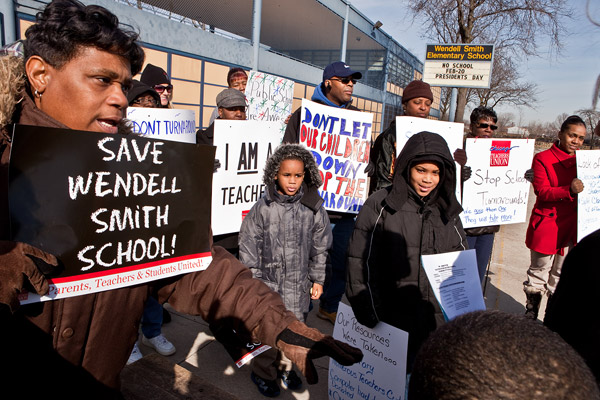
Today WBEZ's Becky Vevea has a report on Drake Elementary, one of the "underutilized" schools that's likely to be closed if and when that plan goes forward. It's a good introduction to the weird math of school closure:
For these small schools, Warner and principals like her all across CPS are faced with a puzzle every year because funding is based on enrollment and “it’s not funded based off of one teacher per grade level anymore,” Warner tells me.
Instead, the district uses a complicated formula to calculate how many teachers a school needs. And often, schools with smaller enrollments, like Drake, don’t get a teacher for every grade.
As a result, classes in underutilized schools are, counterintuitively, overcrowded.
This is partly why CPS officials say school closings are necessary. If Drake had twice as many students it wouldn’t have to combine grade, especially in the early years when research shows small class sizes are more important.
District officials say schools that are under enrolled are also more likely to have crowded classrooms—and not just by a few kids. They’re more likely to be over the district’s class size limit by more than a few students.
So the argument has shifted a bit from savings ("The cash-strapped school district wants to close schools like Drake, not because it will save a lot of money, but because they won’t have to spread resources"). Compare that to a Tribune editorial from a few days ago:
A staggering 330 schools, half the district's schools, are underutilized, meaning they are below 80 percent of what the district has determined to be the ideal student population. That translates into 108,000 empty seats. The system spends millions of dollars to keep those buildings — nearly half built before 1930 — heated, lit and repaired.
That's the thing about school closures, though: you do have to keep them heated and repaired, if not necessarily lit. When a school is closed, it can either be demolished, reused, or sold. The first option is expensive up-front, and can contribute to blight in neighborhoods already suffering from it, but the long-term costs are low. The second can save money if there's a need for the space, but it also means there aren't any savings on maintenance and utilities.
The third is preferable: the city gets money and gets the building off the books. But to be sold, it has to be maintained—that means heating it to 50 degrees during the winter, necessitating a daily check, and best practices suggest a laundry list of maintenance (PDF), not to mention preventing or repairing vandalism. So the building sits, doing nothing, until it's sold. And other cities have found school buildings a tough sell, a Pew report found:
The Milwaukee school system owned 27 surplus school buildings at the start of 2011. In the past few years, only one vacant school has been sold, a former middle school bought for $600,000 in 2010. It is to be turned into senior housing. Tax credits for affordable housing and historic preservation helped make the project feasible.
Chicago's old school buildings have mostly gone to house charters:
In Chicago, 16 buildings have been converted to charters. All of those are leased from the district. Officials said two others became administrative offices and seven are empty. Four have been demolished since 1998, including one that became a hospital parking lot. Other buildings have been reopened by the district as “turnaround” schools.
As a result, districts have found that they aren't saving as much as they anticipated by closing schools. Washington, D.C. just added another $8 million to the expense of closures led by former chancellor Michelle Rhee, and a recent report suggests that further closures in D.C. would barely break even in the first year; it's hard to project beyond that for the above reasons: selling, reusing, or demolishing is a literal gamble. Savings come in future years, though complications like these have brought down estimates, according to the Pew report:
Milwaukee anticipated reducing expenses by $10 million per year in closing 20 schools but so far has saved $6.6 million annually. After closing 23 schools, Washington officials said they have saved about $16.7 million a year, below the initial projections of $23 million. Pittsburgh reported operational savings of approximately $14.7 million per year from closing 22 schools and laying off 279 staff members. Detroit reported that closing 59 buildings saved $35 million in annual operating costs. Kansas City achieved substantial savings by combining closures with 700 layoffs as well as a restructuring of operations that eliminated $30 million paid to outside service-providers.
In any event, the average annual savings, at least in the short run, were well under $1 million per school for the districts studied.
It's a big ballpark; Chicago is estimating $500,000 to $800,000 a year per school.
Photograph: Chicago Tribune


